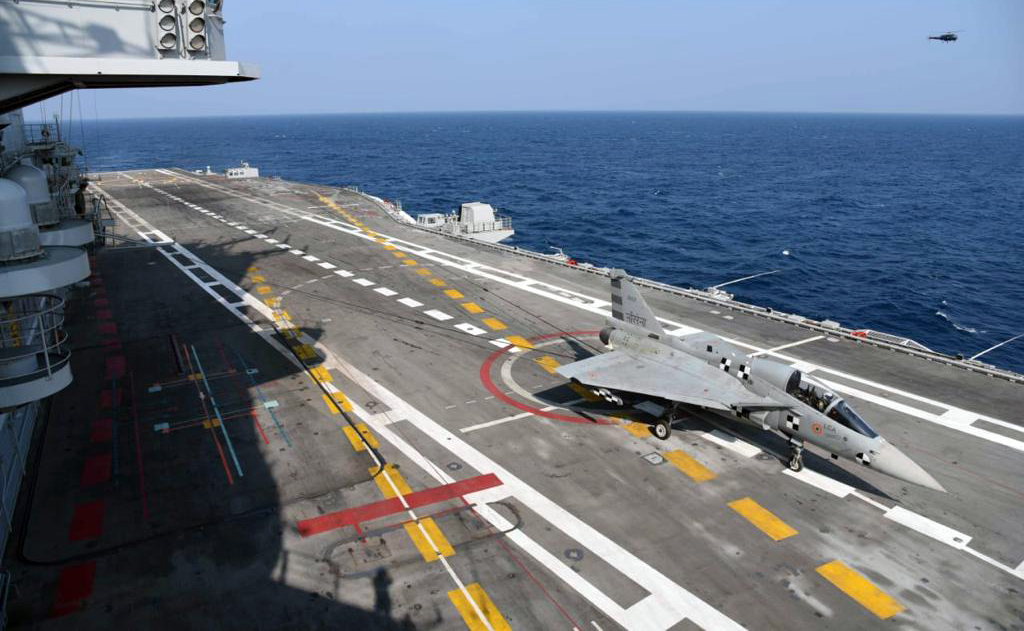The Naval LCA made its first flight on the 27th of April, 2012. It’s been almost 8 years since the delta-winged marine aircraft took to the skies. In this long time, the LCA Programme has taken great strides towards the success of this long drawn out poster-project of successive governments in New Delhi over the years. The Indian Air Force has planned to induct a whopping 324 Tejas (LCA) aircraft in its inventory but what of its Naval counterpart.
There has been a long-standing aversion and scepticism to the Tejas’s viability or even its possibility of operating from the Indian Navy’s aircraft carriers. The Navy lobby has long argued that the Tejas’s ‘light’ characteristic and its single turbofan engine isn’t enough to support operations from aircraft carriers. The Navy has repeatedly requested to be equipped with a much more robust, twin-engine frontline aircraft much like the MiG-29K’s from Russia that the Navy currently uses.
However, the LCA’s manufacturers the Defence Research Development Organisation and the Hindustan Aeronautics Limited have taken to the task of challenging the Navy’s claims. The critical point in the Naval LCA’s life came nearly two years after it took the first flight in 2014. The LCA successfully completed the Ski-Jump Tests at the Shore-Based Test Facility (SBTF) at the INS Hansa. The Navy, soon after the test posted a requirement for about 50 variants of the Naval LCA, the IAF to fast-tracked procurement of its LCA. Currently, an entire operational squadron of the Tejas, The Flying Daggers, exists under the Southern Air Command. Indian Navy pilots have praised the high agility, manoeuvrability and control of the delta-winged Tejas, IAF pilots describe it as the ‘most pilot-friendly’ aircraft of the force.
In January 2020, the Naval LCA successfully completed an arrested STOBAR landing onboard the INS Vikramaditya, the following day the aircraft successfully completed the ski-jump trials onboard the Indian Navy’s lone aircraft carriers. However, the Navy’s aversion remains. The tests have reportedly made it clear that the turbofan engine of the aircraft is unable to match the supposedly high standards of the MiG-29K. The DRDO has offered to use a significantly improved engine that will increase the efficacy of the engine by about 20 % or more.

These setbacks are anti-climactic to Prime Minister Narendra Modi’s vision for complete indigenization of the Indian Military. The Naval LCA programme has been stymied by bureaucratic and operational hurdles. However, one thing that should be noted however, is that there have been no leadership changes at the DRDO and the HAL or even a demand for accountability in the programme’s snails pace. This is noteworthy because a lot of commentators including myself hold these ‘setbacks’ as strategic in order to keep up greater secrecy for the Navy’s capabilities in the face of increased Chinese threats. The Indian Government has done this on various occasions over the past, the most shocking of them was India’s Nuclear Tests at the turn of the millennium. The Indian Air Force for over two decades operated the MiG-25R ‘Foxbats’, the fastest and the most potent reconnaissance fighters on the planet. Noone, even in the air force, knew of its existence. The world only knew about it when they were decommissioned two decades ago.
Whether the Naval LCA is the jewel in the Indian Navy’s dower or it is indeed lead for the Navy remains to be seen but one thing is for sure, India is now among the only countries that can successfully develop and land aircraft on carriers.



